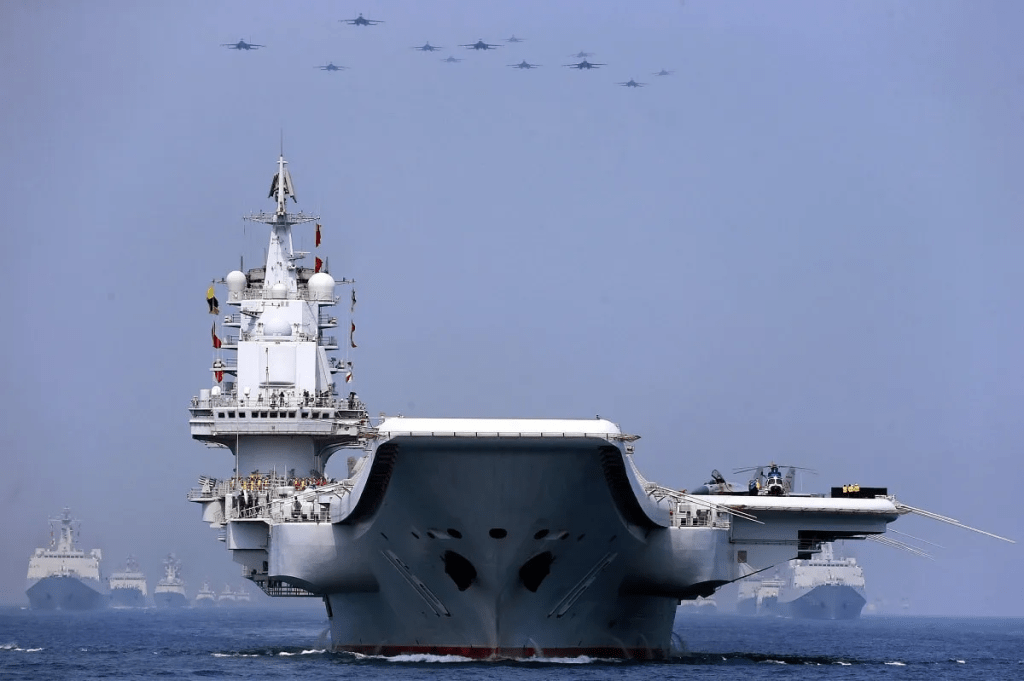China’s Fujian carrier flexes tech race
China’s Fujian carrier flexes next-gen launch tech
China’s latest aircraft carrier is testing an advanced electromagnetic launch system, marking a great leap forward for its naval power projection
AsiaTimes by Gabriel Honrada • November 28, 2023 // The EurAsian Times
China’s Type 003 Fujian aircraft carrier has commenced testing its state-of-the-art electromagnetic catapults for launching jet fighters, marking a new era in Chinese naval power.
The Chinese carrier displaces over 80,000 tons, measures approximately 316 meters in length and can carry 70 aircraft including J-15 fighters and Z-9C anti-submarine helicopters.
This month, Naval News reported that China’s Type 003 Fujian aircraft carrier has started testing its electromagnetic aircraft launch system (EMALS), a significant upgrade from traditional steam catapults which use steam piped from the ship’s turbines to launch aircraft.
Electromagnetic catapults can launch heavier aircraft, meaning more types can be launched from a carrier while each fighter aircraft can carry more fuel and weapons. It is also said to be gentler on the jet airframes, reducing maintenance downtime.
Naval News shows footage from social media with the carrier conducting dead load launch tests, a standard procedure for carriers equipped with catapults. The source mentions this testing phase involves launching test vehicles from the carrier’s catapults to validate their functionality.
It notes that the Fujian was observed moving away from its berth, sparking speculation about an imminent sea trial linked to the catapult testing. However, Naval News says the timeframe for further testing remains uncertain but a sea trial may happen shortly.
The Naval News report notes that the Fujian represents a significant advancement for the People’s Liberation Army-Navy (PLA-N) as the first Chinese carrier equipped with EMALS and featuring several technological firsts.
It says the Fujian’s development, construction and testing phases are being closely monitored with frequent updates shared through overflight and satellite imagery on social media.
Naval News compares the Fujian with the US Navy’s USS Gerald R Ford (CVN-78), which is also equipped with EMALS. Despite the similarities, however, the Chinese system differs technically from the American EMALS.
The report says that the USS Gerald R Ford’s testing timelines and challenges might only provide a broad reference for Fujian’s progress as the Chinese carrier faces unique challenges.
The USS Gerald R Ford experienced multiple delays before entering service linked to constant redesigns and rebuilds from incorporating multiple advanced technologies on a carrier for the first time, such as the EMALS, Advanced Arresting Gear (AAG) and Advanced Weapon Elevator (AWE).
The Fujian, the first PLA-N carrier of its size and capabilities, began construction some time before 2018 and was launched in June 2022. It is expected to undergo extensive trials and testing, potentially leading to commissioning in 2025.
China’s carrier fleet is set for rapid expansion. In a June 2023 article for Aviation Week Network, Bradley Perrett notes that the Fujian’s successful sea trials would pave the way for a fourth Chinese nuclear-powered carrier and up to six carriers by 2040. Perrett also predicts that China’s shipborne fighter numbers will quadruple over the coming decade.
Perrett says Fujian took around six years to construct while the Shandong was completed in just 4.5 years, although it was not put into operation until 1.6 years later.
He mentions China could have five carriers by 2030 if it starts building fourth and fifth ships soon, possibly by next year. Perrett notes that one of the upcoming carriers could be made by Dalian Shipbuilding, the shipyard in northeast China that constructed the Liaoning and Shandong. He suggests Shanghai Jiangnan, Fujian’s builder, could build the other simultaneously.
China’s first carrier, Liaoning, is based in Qingdao, East China’s Shandong Province, near the East China Sea, Yellow Sea, and Bohai Sea. The second carrier, Shandong, is based in Sanya, South China’s Hainan Province, near the South China Sea. The homeport of Fujian is not yet known.
China is also reportedly exploring the acquisition of more nuclear-powered carriers, a development that would eliminate the requirement for frequent refueling, enhancing the carrier’s operational endurance and autonomy.
“The stranger that is within thee shall get up above thee very high, and thou shalt come down very low.
“He shall lend to thee, and thou shalt not lend to him. He shall be the head, and thou shalt be the tail” Deuteronomy 28:43-44



